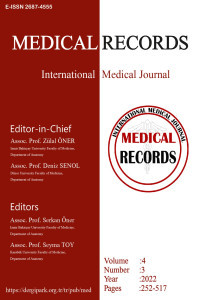Oxidative Stress and Inflammation Markers in Undescended Testes Patients
Oxidative Stress and Inflammation Markers in Undescended Testes Patients
Undescended testes, Oxidative Stress, Inflammation, Cryptorchidism,
___
- 1. Leslie SW, Sajjad H VC. Cryptorchidism. In: StatPearls [Internet]. Treasure Island (FL): StatPearls Publishing, https://www.ncbi.nlm.nih.gov/books/NBK470270/ (2021).
- 2. Rodprasert W, Virtanen HE, Mäkelä JA, et al. Hypogonadism and cryptorchidism. Front Endocrinol (Lausanne). 2020;10:906.
- 3. Gurney JK, Mcglynn KA, Stanley J, et al. Risk factors for cryptorchidism. Nat Rev Urol. 2017;14: 534.
- 4. Wilkerson ML, Bartone FF, Fox L, et al. Fertility potential: a comparison of intra-abdominal and intracanalicular testes by age groups in children. Horm Res Paediatr. 2001;55:18–20.
- 5. Petterson A, Richiardi L, Nordenskjold A, et al. Age at surgery for undescended testis and risk of testicular cancer. N Engl J Med. 2007; 356:1835–41.
- 6. Aldahhan RA, Stanton PG, Ludlow H, et al. Experimental cryptorchidism causes chronic inflammation and a progressive decline in sertoli cell and leydig cell function in the adult rat testis. Reprod Sci. 2021;28:1–13.
- 7. Loebenstein M, Thorup J, Cortes D, et al. Cryptorchidism, gonocyte development, and the risks of germ cell malignancy and infertility: A systematic review. J Pediatr Surg. 2020;55:1201–10.
- 8. Imamoğlu M, Bülbül SS, Kaklikkaya N, et al. Oxidative, inflammatory and immunologic status in children with undescended testes. Pediatr Int. 2012;54:816–9.
- 9. Shiraishi K, Takihara H, Matsuyama H. Elevated scrotal temperature, but not varicocele grade, reflects testicular oxidative stress-mediated apoptosis. World J Urol. 2010;28:359–64.
- 10. Ritchie C, Ko EY. Oxidative stress in the pathophysiology of male infertility. Andrologia. 2021;53:e13581.
- 11. Sposito C, Camargo M, Tibaldi DS, et al. Antioxidant enzyme profile and lipid peroxidation products in semen samples of testicular germ cell tumor patients submitted to orchiectomy. Int Braz J Urol. 2017;43:644–51.
- 12. Erel O. A new automated colorimetric method for measuring total oxidant status. Clin Biochem .2005;38:1103–11.
- 13. Erel O. A novel automated direct measurement method for total antioxidant capacity using a new generation, more stable ABTS radical cation. Clin Biochem. 2004;37:277–85.
- 14. Eggert-Kruse W, Kiefer I, Beck C, et al. Role for tumor necrosis factor alpha (TNF-α) and interleukin 1-beta (IL-1β) determination in seminal plasma during infertility investigation. Fertil Steril. 2007;87:810–23.
- 15. Güler EM, Yiğit M, Özer ÖF, et al. Oxidative Stress and Inflammation Biomarkers in Acute Pancreatitis. Kocaeli Med J. 2021;10:187–93.
- 16. Ikeda M, Kodama H, Fukuda J, et al. Role of Radical Oxygen Species in Rat Testicular Germ Cell Apoptosis Induced by Heat Stress. Biol Reprod. 1999;61:393–9.
- 17. Turner TT, Lysiak JJ. Oxidative Stress: A Common Factor in Testicular Dysfunction. J Androl. 2008;29:488–98.
- 18. Li YC, Hu XQ, Xiao LJ, et al. An oligonucleotide microarray study on gene expression profile in mouse testis of experimental cryptorchidism. Front Biosci. 2006;11:2465–2482.
- 19. Alver A, İmamoğlu M, Menteşe A, et al. Malondialdehyde and CA II autoantibody levels are elevated in children with undescended testes. World J Urol. 2014;32: 209–13.
- 20. Avci V, Ayengin K, Alp HH. Oxidative DNA Damage and NOX4 Levels in Children with Undescended Testes. Eur J Pediatr Surg. 2019; 29:545–50.
- 21. Bisht S, Faiq M, Tolahunase M, et al. Oxidative stress and male infertility. Nat Rev Urol. 2017;14:470–85.
- 22. Agarwal A, Rana M, Qiu E, et al. Role of oxidative stress, infection and inflammation in male infertility. Andrologia. 2018;50:e13126.
- 23. Chatterjee S. Oxidative Stress, Inflammation, and Disease. Oxidative Stress Biomater. 2016;35–58.
- 24. Koçak I, Yenisey Ç, Dündar M, et al. Relationship between seminal plasma interleukin-6 and tumor necrosis factor alpha levels with semen parameters in fertile and infertile men. Urol Res. 2002;30:263–67.
- 25. Azenabor A, Ekun AO, Akinloye O. Impact of Inflammation on Male Reproductive Tract. J Reprod Infertil. 2015;16:123.
- Yayın Aralığı: Yılda 3 Sayı
- Başlangıç: 2019
- Yayıncı: Zülal ÖNER
Abdulmecit AFŞİN, Kasım TURGUT, Nurbanu BURSA, Erdal YAVUZ, Taner GÜVEN, Yusuf HOŞOĞLU
CRP and LDH Levels Can Be Used for Support the COVID-19 Diagnose in Intensive Care Unit Patients
Önder OTLU, Zeynep EKER KURT, Feyza İNCEOĞLU, Ulku KARAMAN, Tuğba Raika KIRAN
Vitamin D, VDR, and VDBP Levels Correlate with Anti-inflammatory Cytokine Profile in FMS Patients
Pınar ELLERGEZEN, Alev ALP, Sinan ÇAVUN
Cerrahi Rezeksiyon Gerektiren Transvers Kolon Yerleşimli Pnömatozis Sistoides İntestinalis Olgusu
Anxiety Status in Parents of Infants Referred During National Newborn Hearing Screening
Emre SÖYLEMEZ, Engin KARABOYA, Süha ERTUĞRUL, Nihat YILMAZ, Ahmet KİZMAZ, Muhammed Harun BAYRAK, Abdulkadir ILGAZ
Olcay ÖZDEMİR, Yağız ÖZBAY, Neslihan YILMAZ ÇIRAKOĞLU
Baris GORGUN, Atilla Süleyman DİKİCİ, Hüseyin BOTANLIOĞLU, Fatih KANTARCI, Muharrem INAN
Orbitofrontal Cortex Volumes in Patients Diagnosed with Somatic Symptom Disorder
Burcu SIRLIER EMİR, Murad ATMACA, Aslı KAZĞAN KILIÇASLAN, Sevler YILDIZ, Hanefi YILDIRIM
İsmail ALTIN, Ahmet Sedat DÜNDAR, Erkal GÜMÜŞBOĞA, Mucahit ORUÇ, Osman CELBİŞ, Emine ŞAMDANCI
Identification of Neutrophil/Lymphocyte Ratio as a Unique Biomarker for Migraine Follow-up
